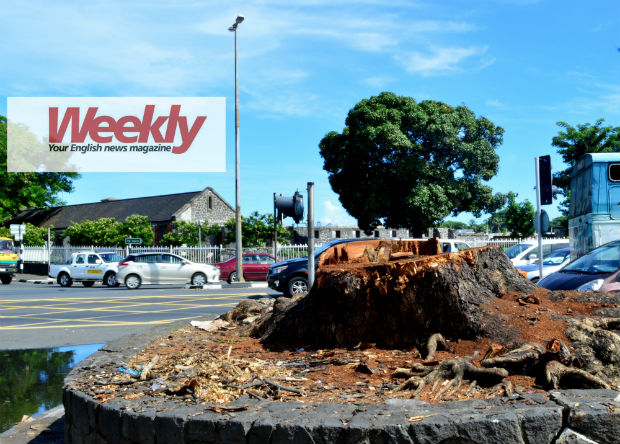Publicité
Aapravasi Ghat: A World Heritage site under threat?
Par
Partager cet article
Aapravasi Ghat: A World Heritage site under threat?


This article was published in Weekly, No. 286, 22 February 2018.
The trees at the Immigration Square and where the Presbyterian Church used to stand, opposite the Aapravasi Ghat, were felled earlier this month (note: in early February). The cutting down was unannounced and seems to be the first step towards the “modernisation of Immigration Square urban terminal” and the construction of the Metro Express by the government. Beyond the emotional and environmental charges carried by the sudden disappearance of these historic trees, the World Heritage status of the Aapravasi Ghat itself seems to be under threat.
The cutting down of the trees at the Immigration Square is to pave the way for the modernisation plans of the Immigration bus terminal, in line with similar plans at Victoria station and with the Metro Express. A request for proposals was published in the press on Tuesday (note: Tuesday 20 February 2018) by the Ministry of Public Infrastructure and Land Transport. The request mentions the leasing of “state-owned land for an infrastructural redevelopment and modernisation project of the Immigration Square at Port Louis on a design, finance, build and operate basis”. Proposals which “best represent the objectives and expectations of Government regarding the redevelopment of Immigration Square” would be considered for the proposed 60–year lease.

Conversely, the “Immigration interchange station”, as termed by the Metro Express contractor Larsen and Toubro, is meant to be the last station on a 19-station line linking Curepipe to Port Louis. The tracks are likely to go through where the Presbyterian Church used to stand, opposite the current entrance to the Aapravasi Ghat and where trees were also logged earlier in the month. The Metro Express was exempted from an Environment Impact Assessment (EIA) licence under Section 28 of the Environment Protection Act which stipulates that “the minister may declare an undertaking [...] by a public department, which, in his opinion, is urgently needed in the national interest or for the economic development of Mauritius, to be an exempt undertaking”. Exemption from an EIA licence allows for a proponent to get away with environmental considerations like the ones outlined in Sections 18(2)(f) and 18(2)(k) of the Act, which respectively force proponents to list “the direct or indirect effects that the undertaking is likely to have on the environment” and “any alternative manner or process in which the undertaking may be carried out so as to cause less harm to the environment”. The Environment Protection Act does not however mention an undertaking being exempted from submitting a Cultural Heritage Impact Statement (CHIS), as laid out in the Planning Policy Guidance 6, specific to the buffer zones of the Aapravasi Ghat and released by the Ministry of Housing and Lands in 2011, to a technical committee responsible for the buffer zones.

Proclaimed a legal entity in 2011, the buffer zones are protected by the Aapravasi Ghat Trust Fund Act (amended 2006 and 2011), the Local Government Act 2003 (amended 2011), and the PPG6. The latter defines “a set of performance criteria and design standards aimed at protecting the heritage authenticity and integrity of the buffer zones”. The PPG6 hence sets out to “support the conservation of the historical fabric” and “the conservation of the urban character and intangible heritage of the World Heritage Property”, amongst other things. While the Aapravasi Ghat is owned by the Ministry of Arts and Culture, the buffer zones are administered by the Municipal Council of Port Louis and the Mauritius Ports Authority (MPA). Accordingly, any development plan within the buffer zones needs to be reviewed and approved by the technical committee, chaired by the City Council of Port Louis and comprising representatives from the Aapravasi Ghat Trust Fund (AGTF); the MPA; the National Heritage Fund; the National Development Unit; and the Ministries of Public Infrastructure and Land Transport, Environment, Tourism, Arts and Culture, and Housing and Lands. The committee’s mission is to ensure that any development plans are in line with the conditions set out by the PPG6.

Confusion
Staffs at the AGTF, who wish to remain anonymous, confirmed to Weekly that neither the AGTF nor the technical committee had been informed of any development projects opposite the World Heritage site. A senior official at the Ministry of Public Infrastructure expressed his surprise when Weekly informed him of the cutting down of the trees. “We are not involved in any projects there; tenders have not even been issued yet,” he said. The City Council of Port Louis remained unreachable to confirm whether they had granted permits. The Road Development Authority and the National Heritage Fund, since the Aapravasi Ghat is also a national heritage, remained unreachable too for a statement. Genuine concerns hence surround the impact of the Metro Express and the modernisation of the Immigration bus terminal on the development vision to “retain a high level of authenticity and integrity” and of “architectural harmony” of the buffer zones as set out by the PPG6.
A risk to the status
Vijaya Teelock, former chairperson of the AGTF, conceded that what is going on within the buffer zones is against planning policy guidance. “The UNESCO ought to be informed of any development projects to be undertaken within the buffer zones. The projects should also be vetted by the technical committee,” states Teelock, who warns,
“The risk is to have the UNESCO list the Aapravasi Ghat as a World Heritage in Danger, and, ultimately, remove the World Heritage status of the Aapravasi Ghat altogether.”
Thierry Le Breton, president of SOS Patrimoine en péril, an NGO working for the conservation of local heritage, denounces the opacity surrounding the planned projects within the buffer zones. “It’s very worrying as not all the national and international stakeholders seem to have been consulted. No one seems to know anything; there’s a disdain for institutions,” says Le Breton. The latter also deplores the lack of “integrated vision” for development within the buffer zones: “Despite my being in favour of development, we merely juxtapose projects.” Le Breton explains that once the UNESCO has been warned of the breach in the buffer zone regulations, a letter will be sent to the local authorities for the situation to be redressed. “In the event the UNESCO deem that irreversible changes have been brought to the buffer zones, or if the authorities ignore the UNESCO’s recommendations, the Aapravasi Ghat could be downgraded to a World Heritage in Danger, and, indeed, eventually be stripped of its World Heritage status,” contends Le Breton. “We are not there yet though,” he nuances.
The equation between environmental considerations and development already seemed cumbersome in Mauritius. Add heritage conservation to it and you get a nightmare for land developers and the authorities. However, regulations and policies have been designed precisely to disentangle this imbroglio. The government, conflicted between being both developer and conservationist in the case of modernising our land transport system, the Aapravasi Ghat and its buffer zones, seems to have already decided which side of the debate it sits on. Even if that implies threatening one of our only two UNESCO World Heritage sites.
What are the buffer zones?
<p>The Aapravasi Ghat was inscribed as a UNESCO World Heritage site in 2006 based on its Outstanding Universal Value (OUV) statement as the site chosen by the British for the “Great Experiment” of indenture. The core zone (the site itself) and two buffer zones surrounding the core zone make up the Aapravasi Ghat World Heritage property. According to the Aapravasi Ghat Trust Fund (AGTF), which administers the site, the buffer zones “represent the context in which the World Heritage property has evolved through time”. The PPG6 adds that the buffer zones are “an important historic urban landscape where the origins and memories of the evolution of the oldest portion of the city are recorded [...]. They cover an area of cultural significance for the history of the Immigration Depot, as nearly 70 per cent of it was located in this area before its destruction in the 20th century. Today, the visual and historical links are preserved between the core zone and its buffer zones as an evidence of common historical evolution.”</p>
For more views and in-depth analysis of current issues, Weekly magazine (Price: Rs 25) or subscribe to Weekly for Rs110 a month. (Free delivery to your doorstep). Email us on: weekly@lexpress.mu
Publicité
Les plus récents






